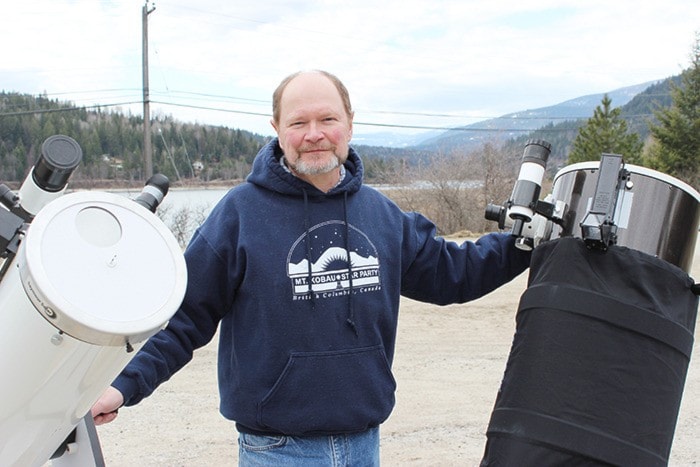When you’re passionate about the night sky and all the wonders deep in space, having someone to share the “wows” takes a hobby to the next level.
“Often when I was doing this on my own, I’d look at a star cluster and I’d say wow and I’d realize there was no one around to share that with,” says Wayne Holmes, star gazer extraordinaire. “So here I am, I get to share this with people and most of the time they go ‘wow’ too … When someone looks through the eye piece at Saturn or the Orion nebula, they’re just floored and that in itself is a reward.”
Holmes has been hosting Taghum Starry Nights and Solar Sundays as a labour of love and he just started up his third season.
People are invited to share the wows Friday night just outside Nelson at the Taghum Hall where Holmes sets up his telescopes for public use.
Looking back on his keen childhood interest in outer space, helping children by encouraging their curiosity is another of his motivators today.
“When I was a kid, if someone was doing this, I would be over the moon ... I remember being a small kid, even before I went to school, looking through books and seeing pictures of Saturn, thinking I want to see that. I want to see the rings of Saturn,” he says. “Who knows some of these kids could go on and discover what dark energy is or dark matter and they can explain it to me.”
Holmes is a retired jewelry designer who grew up in the light polluted Lower Mainland. He moved to the Kootenays in 2007, loving the beautiful, dark night skies.
“We just need to flatten the mountains a little bit,” he says.
With his reflecting telescopes — one 8 inches, one 12.5, and a hydrogen alpha scope — Holmes also sets up for schools and summer science camps volunteering with Kootenay Association for Science and Technology. Starry Nights started in 2010 and have been successful. One night last summer, the social evening lasted until 2 a.m. with about 40 people out enjoying the night sky.
This season people can expect a tour of the night sky, says Holmes. He intends to keep each evening focused on one subject.
“Certainly we will be looking at Jupiter. It’s up now and it’s gorgeous. We’ll be looking at the comet Pan-STARRS. It’s disappearing but it’s certainly something to see through a telescope,” he says.
The enthusiast will share his vast knowledge — mostly from reading and taking lectures, on stars. In the southwestern sky, the Orion nebula is one of the larger and brighter star birth areas of the Northern Hemisphere, he says.
Holmes will explain the various types of stars, talk about their colours, how they’re formed and how they die.
“There’s this star called Betelgeuse which is an aging star. It’s going to go super nova. This is a monster star that is out of control. It looks orange,” he says. “Then we’ll look at a hot blue star — Nigel and compare the two. We’ll look at another star Sirius; it’s the brightest star in the night sky. It’s so luminous and so energetic that when it’s low in our atmosphere, all the photos are hitting our atmosphere and breaking up. It breaks into various light waves — blue, red, green, and yellow.
“When you look at the star, especially if I knock the scope out of focus, it looks like a sparkling diamond or a kaleidoscope. You see the colours flashing and moving all over the place. I had an aging hippy come by and look at it — he said ‘oooh, that’s psychedelic.’”
“We’ll go to Perseus or Gemini where there are open star clusters. This is what’s left when all the star forming is finished. You get this tight cluster of stars and they’re absolutely beautiful because you’ve got so many stars compacted in such a tight area. Just the shear beauty of it gets a lot of people going.
“Eventually we’ll look at the death of stars.”
Solar Sundays will also begin in May and Holmes invites people look through a filtered telescope that blocks out 99 per cent of the sunlight.
“With this we can see sunspots quite clearly and the Penumbra that’s around the sunspots where it’s collapsing in,” he says.
He also uses his hydrogen alpha scope to view the sun. It’s a smaller scope that allows only narrow hydrogen light waves through allowing people to see prominences, flares, and the texture on the photosphere of the sun.
“If we’re lucky we see solar flares — one time we saw a mass coronial ejection. That was with a kids’ summer science camp. It just blew right out.”
The sun is expected to continue to be very active this summer.
“This year is the solar maximum. It’s just going to go crazy,” he says.
Starry Nights are a go; weather permitting, on April 5 and 12 with more being hosted in May. Solar Sundays start up again on May 5. The viewing events are open to everyone by donation — goes toward better equipment.
Anyone interested in more information or wanting to get on an email list can contact Holmes at 250-354-1586.
The program can be cancelled due to poor weather and will be cancelled one hour before sunset.
